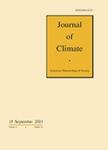版权所有:内蒙古大学图书馆 技术提供:维普资讯• 智图
内蒙古自治区呼和浩特市赛罕区大学西街235号 邮编: 010021

作者机构:Univ Washington Dept Atmospher Sci Box 351640 Seattle WA 98115 USA Ulsan Natl Inst Sci & Technol Sch Urban & Environm Engn Ulsan South Korea Columbia Univ Lamont Doherty Earth Observ Palisades NY USA
出 版 物:《JOURNAL OF CLIMATE》 (气候杂志)
年 卷 期:2016年第29卷第12期
页 面:4543-4564页
核心收录:
学科分类:07[理学] 070601[理学-气象学] 0706[理学-大气科学]
基 金:NDSEG fellowship NSF IGERT Program on Ocean Change traineeship NSF [AGS-0846641, AGS-0936059, AGS-1359464, PLR-1341497] UW Royalty Research Fund grant Basic Science Research Program through the National Research Foundation of Korea (NRF) - Ministry of Science, ICT and Future Planning [2013R1A1A3004589] AGS-1433551
主 题:Geographic location/entity Intertropical convergence zone Circulation/ Dynamics Energy transport Hadley circulation Atm/Ocean Structure/ Phenomena Monsoons Precipitation Models and modeling General circulation models
摘 要:A subtropical continent is added to two aquaplanet atmospheric general circulation models (AGCMs) to better understand the influence of land on tropical circulation and precipitation. The first model, the gray-radiation moist (GRaM) AGCM, has simplified physics, while the second model, the GFDL Atmospheric Model version 2.1 (AM2.1), is a fully comprehensive AGCM. Both models have a continent that is 608 wide in longitude from 10 degrees to 30 degrees N, in an otherwise slab-ocean-covered world. The precipitation response varies with cloudy-and clear-sky feedbacks and depends on continental albedo. In GRaM simulations with a continent, precipitation in the Northern Hemisphere decreases mostly as a result of decreased evaporation. In AM2.1 simulations, precipitation also shifts southward via Hadley circulation changes due to increasing albedo, but the radiative impact of clouds and moisture creates a more complex response. Results are similar when a seasonal cycle of insolation is included in AM2.1 simulations. The impact of a large, bright subtropical continent is to shift precipitation to the opposite hemisphere. In these simulations, the hemisphere of greater tropical precipitation is better predicted by the hemisphere with greater atmospheric energy input, as has been shown in previous literature, rather than the hemisphere that has higher surface temperature.